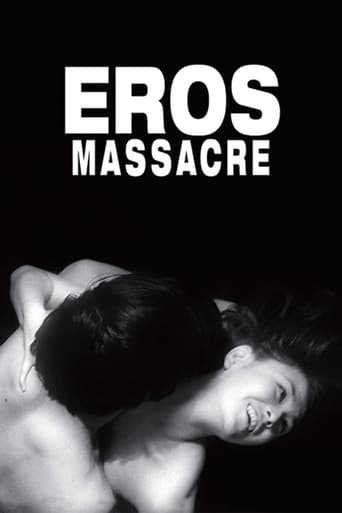zetes
The Japanese New Wave is one of my favorite cinematic movements, and this film comes recommended as one of the best of its era. Very unfortunately, it didn't do much for me at all. The one thing about it that I'll say right off the bat really impressed me was the cinematography. No time and place ever produced such gorgeous black and white movies, and this is up there with the best.The film itself, though, is very slow-moving, kind of pretentious, and uninvolving. The story involves two timelines, one set in the Taisho period (starting in 1916) and the other in the present. It's about free love and the sexual revolution. In 1916, the philosopher Sakae Osugi practices and writes about free love. I'm pretty sure the Japanese word for philosopher translates literally in English to "aloof jerk," because this guy's version of free love is to screw around with different women and then say "Why can't you be chill about this?" when they confront him. In particular, Itsuko Masaoka becomes wildly jealous when he starts seeing Noe Ito on the side. She begins brandishing a knife, always threatening to get stabby with it. Late in the movie, there are like three consecutive sequences that take up a good quarter of the movie where she fulfills her promise.The 1960s stuff involves two students who are studying Osugi. They have their own problems, but want to subscribe to the free love idea, which seems to be expanding around the world. At least in the director's cut, these segments take up only about a quarter of the film.Look, I don't generally do well with long films, and perhaps this one's 3 hours and 36 minutes were just too daunting for me. The fact is, though, from the very beginning I was pretty bored with this one. 90% of the scenes just involve two or three people sitting around in a room bickering. I give Yoshida much credit for keeping it visually interesting throughout. The guy definitely has talent, but I wonder if this independently produced art film gave him too much freedom. Maybe he'd be better reigned in.Whatever the case, I'm still perfectly happy to have this new Arrow Academy box set. Outside of Criterion, they're the best home video production company today. I hope I like the other two films better, and I hope one day I get to take a look at Yoshida's earlier, studio-produced films.
gavin6942
Two interwoven stories. The first is a biography of anarchist Sakae Osugi (1885-1923) which follows his relationship with three women in the 1920s. The second centers around two 1960s' students researching Osugi's theories.This film is epic, even in its cut form. Yoshishige Yoshida uses a variety of clever, yet subtle, techniques including the idea of reflection to show the split time frames. Unfortunately, the film's shades of gray are not as stark as they could be.The film is generally considered to be one of the finest film to come out of the Japanese New Wave movement, and sometimes one of the best Japanese films in general. Although relatively unknown in the West, it has gained a small cult following. Thanks to Arrow Video, it can now be seen uncut on Blu-ray. Personally, it is not my cup of tea, but not everything can be.
GRWeston
When I was recommended a 180+ minute Japanese biopic about someone I had never heard of, directed by someone I was not aware of and made in perhaps my least familiar era for film (the 60's), my first reaction was "what did I ever do to you?" However, now that those 180+ minutes are lodged - deeply, I might add - in my memory, I would have to say that I did not receive a burden, but instead a big favor. Eros Plus Massacre provided a unique and challenging experience. If anything, it shook my perceptions of the biopic format.The subject of Eros Plus Massacre is Sakae Osugi (1885-1923), a Japanese radical who advocated anarchy and a way of life that went against as many social norms as possible. This lifestyle included refusing to work, not paying taxes and free love with as many partners as possible. The film covers the period when Osugi established his philosophy to when he practiced it and the moment when his radical views got the better of him: he died at the hands of a police squad, who beat him, his lover – fellow practitioner Noe Ito – and young nephew to death. While the film relies on the rise and fall story structure conventional to biopics, how it goes about telling this story is far from conventional. The plus in the title, for instance, is relevant: the film is roughly divided into halves, the aforementioned incident with the police – better known as the Amanasu Incident – serving as the first half's climactic moment, while the second half focuses on an intriguing and contentious incident where Osugi was stabbed by another, jealous lover, a moment that is repeatedly reinterpreted Rashomon-style.Free love, refusing to obey the man, embracing alternative philosophies: is this the early 20th century, or is it the 60's? Yoshida expresses these similarities by making it appear that the film is under the direction of a student couple who are just as promiscuous, freewheeling and philosophical as Osugi and his lover. The film shifts between scenes with Osugi and the students without a moment's notice, the connections between them not becoming entirely clear until later. Whether due to Yoshida's directing style or my own unfamiliarity with the subject, I first assumed that the students were the young Osugi and Ito, and that the film was taking the kind of broken time line narrative approach that Tarantino would likely cite as an inspiration. The director's use of music, however, eventually made it all clear: the Osugi scenes use traditional Japanese instruments while the student ones are filled with psychedelic rock. Most of the film consists of conversations between the two couples, set against a series of distinctive, disparate (and very sparsely populated) set pieces, ranging from a garden-secluded traditional Japanese home to the underside of a massive highway system. While the truth may be that the director could not afford to hire any extras to fill these backdrops, their emptiness actually works to accentuate the characters' isolation as well as how their self-centered philosophies made the world seem like their own personal playground. In this way, the film reminded me a lot of Antonioni's L'Avventura in its emptiness, attitude towards the subjects' listless behavior (and perhaps in its repetition).Is a life of anarchy sustainable? Do our social norms like gainful employment, marriage, etc. exist solely to empower the elite? The film leaves the answers to such questions up to the viewer, and while Osugi's ways led to his demise, the incident is presented in a very matter-of-fact manner. Even so, this hands-off approach does not always work in the film's favor. As I mentioned with my initial confusion over the use of the students, there are a few moments that would come across as obtuse or extraneous even to the Osugi scholar. There were also scenes that, while impressive aesthetically, did not really add anything new to the picture of Osugi's psyche. Still, it is all material that I wish more films these days would contain, or at least attempt to mimic.
Steven_Harrison
Yoshida's Eros Plus Massacre is an AMAZING example of what narrative cinema can do with time and space, establishing characters that exist in a world of their own and yet feel very real (and are in fact based on some real people.) Ito Noe and Osugi Sakae were lovers and friends who fanned the flames of anarchist and leftist controversy during one the Taisho era (Japan's Weimar or Roaring 20s.) Noe was a writer who became Osugi Sakae's, an anarchist revolutionary and writer, lover. They were murdered by the state police after the Kano earthquake of 1923 (which was, in some ways and places, blamed on anarchist, immigrants, and other illogical things.) Yoshida places us in the present day through rebellious college students, one an extremely sexual female who plays games with police and film directors the entire movie, the other a nearly impotent young man who is obsessed with current events and fatalism. They replay the Taisho events in their imaginations, which we are privy to, until the imaginations begin to take place within their own reality. Soon, the two are intertwined, and we're asked as viewers to deal with some improbable and unforgettable situations that question our role as a passive audience. The story and characters of both time periods are engrossing, and combined with Yoshida's radical compositions and a combination of subdued "historical" music and late 60s trippy rock, you're thrown into a delightfully open ended plot which you'll have a hard time shaking.Yoshida's debt to Alain Resnais is on full display here. The film is a near sister to Last Year at Marienbad and Muriel. Antonioni's desolation films also come to mind, particularly The Eclipse. Yoshida's place in the Nuberu Bago (the Japanese New Wave) was cemented when David Desser named his book about the movement after this film, and its worth the advertisement. This is available in Japan without subs, and you can probably find it somewhere in the trading world with English subtitles, but it needs a proper DVD release (along with EVERY OTHER YOSHIDA film.) Highly highly recommended to any film fan with an open mind.




